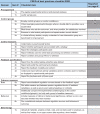Consensus on the reporting and experimental design of clinical and cognitive-behavioural neurofeedback studies (CRED-nf checklist)
- PMID: 32176800
- PMCID: PMC7296848
- DOI: 10.1093/brain/awaa009
Consensus on the reporting and experimental design of clinical and cognitive-behavioural neurofeedback studies (CRED-nf checklist)
Abstract
Neurofeedback has begun to attract the attention and scrutiny of the scientific and medical mainstream. Here, neurofeedback researchers present a consensus-derived checklist that aims to improve the reporting and experimental design standards in the field.
Keywords: checklist; consensus; guidelines; neurofeedback; regulation.
© The Author(s) (2020). Published by Oxford University Press on behalf of the Guarantors of Brain.
Figures


References
-
- Albers C, Lakens D. When power analyses based on pilot data are biased: inaccurate effect size estimators and follow-up bias. J Exp Soc Psychol 2018; 74: 187–95.
-
- Algermissen J, Mehler DM. May the power be with you: are there highly powered studies in neuroscience, and how can we get more of them? J Neurophysiol 2018; 119: 2114–7. - PubMed
-
- Campbell DT, Stanley JC. Experimental and quasi-experimental designs for research. Ravenio Books; 2015.
Publication types
MeSH terms
Grants and funding
LinkOut - more resources
Full Text Sources
Other Literature Sources
Medical

